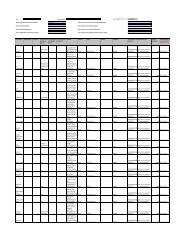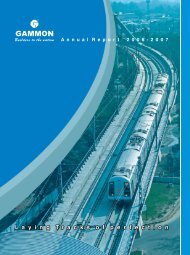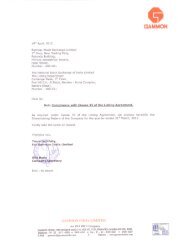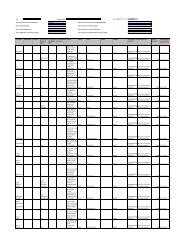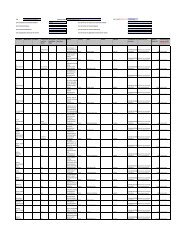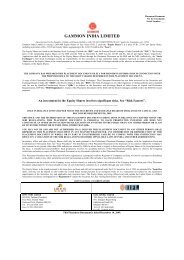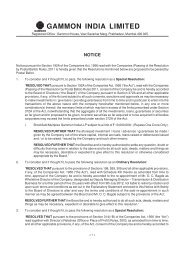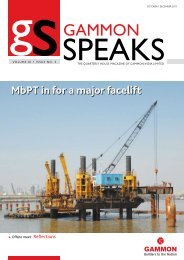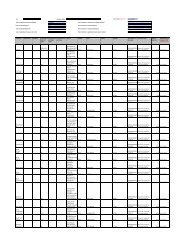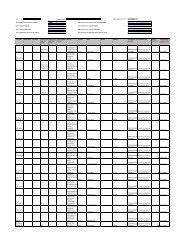Annual Report 2010-2011 - Gammon India
Annual Report 2010-2011 - Gammon India
Annual Report 2010-2011 - Gammon India
Create successful ePaper yourself
Turn your PDF publications into a flip-book with our unique Google optimized e-Paper software.
SCHEDULE 17 : SIGNIFICANT ACCOUNTING POLICIES AND NOTES TO THE CONSOLIDATED FINANCIAL STATEMENTS<br />
A. ACCOUNTING POLICIES:<br />
1. Principles of consolidation<br />
The Consolidated Financial Statements comprise the financial statements of GAMMON INDIA LIMITeD (“the Company”) and its Subsidiary<br />
companies (the Company and its subsidiaries are hereinafter referred to as ‘the Group’), Associates and Joint Ventures (JV’s) in the form of jointly<br />
controlled entities. The Consolidated Financial Statement has been prepared on the following basis:<br />
124<br />
(a) Interests in Subsidiaries<br />
• The Financial Statements of the Company and its subsidiary companies have been combined on a line by line basis by adding the<br />
book values of like items of assets, liabilities, income and expenses, after fully eliminating intra-group balances and intra-group<br />
transactions resulting in unrealized profits or losses as per Accounting Standard-21 “Consolidated Financial Statements” issued by<br />
Institute of Chartered Accountants of <strong>India</strong> (‘AS-21’).<br />
• The Consolidated Financial Statements have been prepared using uniform policies for like transactions and other events in similar<br />
circumstances and are presented to the extent possible in the same manner as the Company’s separate financial statements.<br />
• The excess of cost of investments of the Company over its share of equity in the Subsidiary is recognised as goodwill. The excess of<br />
share of equity of Subsidiary over the cost of investments is recognised as capital reserve.<br />
• The revenue related to construction services in respect of the BOT contracts, which are governed by Service Concession Agreements<br />
with government authorities (grantor), is considered as exchanged with the grantor against toll collection rights/annuities receivable,<br />
profit from such contracts is considered as realized. Accordingly, BOT contracts awarded where work is subcontracted within the<br />
group, the inter group transactions on BOT contracts and the profits arising thereon are taken as realised and not eliminated.<br />
(b) Interests in Joint Ventures<br />
The Company’s interests in Joint Ventures in the nature of jointly controlled entities are included in these Consolidated Financial Statements<br />
using the Proportionate Consolidation Method as per the Accounting Standard–27 “Financial <strong>Report</strong>ing of Interests in Joint Ventures”<br />
issued by the Institute of Chartered Accountants of <strong>India</strong> (‘AS-27’). The group combines its share of each of the assets, liabilities, income<br />
and expenses of the joint venture with similar items, on a line by line basis.<br />
(c) Investment in Associates<br />
Investments in Associate Companies are accounted under the equity method as per the Accounting Standard–23 “Accounting for<br />
Investments in Associates in Consolidated Financial Statements” issued by the Institute of Chartered Accountants of <strong>India</strong> (‘AS -23’).<br />
Under the Equity Method, the investment in associates is carried in the balance sheet at cost plus post acquisition changes in the Group’s<br />
share of net assets of the associate. The income statement reflects the Group’s share of the results of operations of the associates.<br />
The excess of the Company’s cost of investment over its share of net assets in the associate on the date of acquisition of investment is<br />
accounted for as goodwill. The excess of the Company’s share of net assets in the associate over the cost of its investment is accounted<br />
for as capital reserve.<br />
Goodwill/Capital Reserve is included/adjusted in the carrying amount of the investment.<br />
2. Use of Estimates<br />
The preparation of financial statements in conformity with Generally Accepted Accounting Principles requires management to make estimates<br />
and assumptions to be made that affect the reported amount of assets and liabilities and disclosure of contingent liabilities on the date of<br />
financial statements and the reported amount of revenues and expenses during the reporting period. Difference between the actual results and<br />
estimates are recognized in the period in which the results are known.<br />
3. Revenue Recognition<br />
(a) On Construction Contracts:<br />
Long-term contracts including Joint Ventures are progressively evaluated at the end of each accounting period. On contracts under<br />
execution which have reasonably progressed, profit is recognised by evaluation of the percentage of work completed at the end of the<br />
accounting period, whereas, foreseeable losses are fully provided for in the respective accounting period. The percentage of work completed<br />
is determined by the expenditure incurred on the job till each review date to total expected expenditure of the job.<br />
Additional claims (including for escalation), which in the opinion of the management are recoverable on the contract, are recognised at the<br />
time of evaluating the job.<br />
(b) In case of certain high end boilers the milestones method is used for the measurement of the stage of completion, so as to ensure greater<br />
compliance of the valuation in the financial statements with respect to the effective stage of completion of the activities.<br />
(c) On supply of materials related to the transmission towers, revenue is recognized upon the delivery of goods to the client in accordance<br />
with the terms of contract. Sales include excise duty & other receivable from the customers but exclude VAT, wherever applicable.<br />
(d) Revenue from providing services are recognized in income statement at the moment said services are completed. As for works in progress,<br />
they are measured based on the status of completion of work. Whenever the results of the agreement cannot be reliably evaluated,<br />
revenues are recognized only to the extent that costs are deemed to be recoverable.<br />
(e) Insurance claims are accounted for on cash basis.<br />
(f) On Infrastructure Development Business:<br />
(i) Annuity and Toll Receipts:<br />
The toll fees collection from the users is accounted when the amount is due and recovered.<br />
A NNUAL R EPORT I <strong>2010</strong>/11





